Spiced Fruit Sourdough
Spiced Fruit Sourdough uses my easy, overnight, no-knead bread baking method to create a loaf full of rich flavour.
Dried fruits are steeped in honeyed black tea and orange zest and folded into a spiced dough made the night before.
Using the soaking liquid in place of water in the dough adds even more flavour.
Baked in a covered pot, the loaf is moist but with a crunchy crust.
Lovely eat spread with butter or cheese. Great toasted too.
Jump to Recipe
For this year’s Sourdough September, an initiative of the Real Bread Campaign to promote the making of proper sourdough, I’d set myself the challenge of creating some new, flavoured versions of my basic sourdough bread recipe.
First was my Sourdough Beer Bread which turned out pretty good. Even better was a Roasted Onion Sourdough with Flaxseeds & Toasted Bulgur
But, for my final experiment I decided to make a sweet rather than savoury loaf
The result was Spiced Fruit Sourdough.
To be honest though, the development of this recipe was a bit of a rollercoaster ride.
I was excited by the challenge and loved the smells as I was prepping and baking the bread.
But I was a little concerned that the dough hadn’t risen that much, either overnight or in the oven.
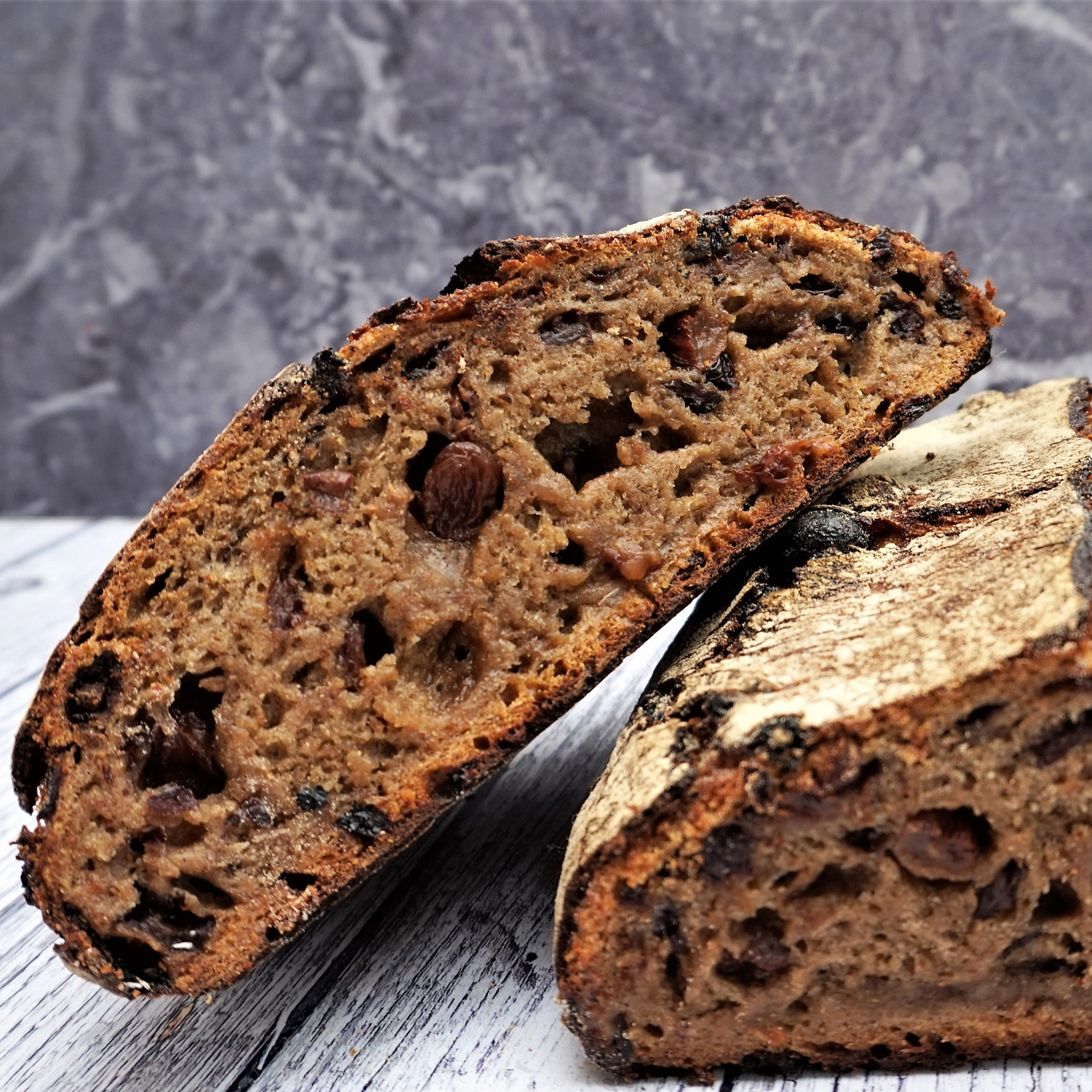
However, my fears of a heavy loaf weren’t realised. As I hope you can see from the images, even with the addition of some rye flour, it still had the characteristic open structure of sourdough too.
SPICED FRUIT SOURDOUGH
When we were growing up, my mother often made a fruit cake where the fruit was soaked in black tea to intensify the flavour. I decided to incorporate this idea into my recipe.
This made me think of Welsh Bara Brith or ‘speckled bread’.
But when I looked at recipes for inspiration, most versions seemed to be more cake-like than bready, using self-raising flour. However, I knew I didn’t want to go in the cake direction. After all, the whole point of the experiment was to widen my repertoire of sourdough bread.
So I decided to stick to my basic sourdough recipe but replace the water with the soaking tea,sweetened with honey. I added grated orange zest too as this always goes well with fruit breads.
I also wanted to add spices to my bread.
After toying with the idea of cinnamon and ginger, I finally settled upon two-thirds mixed spice and one-third cinnamon. The mixed spice in my cupboard seemed very nutmeggy and I thought the extra cinnamon would balance out the flavour a little. [Since writing this recipe, I’ve also made a version which uses chai masala spices and chai tea to soak the fruit. I’ve added this variation at the end of this post].
MY SOURDOUGH METHOD
For all my sourdoughs, you need to start the bread making process the night before you want to bake.
Actually, if like me you store your starter in the fridge between irregular baking, you’ll need to plan a bit further ahead.
This is so you can feed it and bring it back to bubbly life again over several days.
My sourdough method is an overnight one. I always feed the starter mid-morning and then mix up the dough in the evening before leaving overnight.
Before beginning this recipe, you might want to first read my No-knead Sourdough post. This will give you an overview of my no-knead, overnight method. You’ll also learn why I bake bread in a lidded cast iron casserole and find a link to making your own starter.
I made the hot, honeyed tea in the morning and left the fruit and zest to steep in it all day. This meant I could incorporate the cold soaking liquid into the dough that evening. You could probably get away with just a few hours. But it was convenient for me to do it this way.
I usually mix 400 ml of water in my bread doughs. However, I knew the fruit would suck up some of it, so made 500 ml of tea for my Spiced Fruit Sourdough.
When I was ready to make the dough, I strained the fruit through a fine sieve, pushing down on the fruit to get most of the liquid out of them. I put the fruit in a covered bowl in the fridge as I wouldn’t be incorporating it into the dough until the next morning.
By the way, when you’re sieving, remember to do it into a jug, not down the sink! Sounds obvious, but I’ve lost precious cooking liquors more than once that way!
Mixing the dough is really simple. I used one-third rye flour, two-thirds white wheat bread flour and mixed in the spices and salt. I dissolved the starter in the reserved soaking liquid which made it look like milky tea.
With a rubber spoon, I mixed the two together into a rather wet and sticky dough. Don’t attempt to knead the dough – you’ll get in a mess. As you can see from the image below, the dough will be rough looking, but don’t worry. It’s supposed to be like that at this stage.
Next, I covered the bowl with cling-film and left it overnight and part of the morning: a total of 15 hours.
THE NEXT DAY
Because I’d used a fair bit of rye flour, which contains less gluten, the dough had not risen greatly by morning. But the smell was lovely and spicy.
To incorporate the plumped fruit, I flattened out the dough on a very well-floured work surface. Make sure you’ve plenty of extra flour to hand to do this as it can get quite sticky!
I find it easiest to start with half the fruit. Sprinkle it over the surface of the flattened dough then bring over the sides, right and left, to cover the filling. The fold over the top and bottom edges. Using a dough scraper really helps with wet, sticky doughs.
Flatten the dough again, then top with the remaining fruit. Fold the sides over again.
I kept folding the dough over itself until the mixture was incorporated throughout.
Folding the sides over the middle, then folding in half a couple of times will help to improve the finished texture of the dough anyway and should help to create the classic hole-filled crumb of a sourdough loaf.
When I’m happy with the state of the dough, I work it into the rough shape of my well-floured proving basket. If you don’t have a proving basket then use a tea towel-lined bowl, well floured.
Leave the dough on on the work surface to rest for 10 minutes first though, covered with cling film or the upturned bowl.
After 10 minutes, I gave it another quick fold then put it in the proving basket, covered it, then left it for 90 minutes.
BAKING
For the final 30 minutes of proving time, I pre-heated the oven to 250 degrees centigrade (500F or Gas 10). I put in a cast-iron pot (I use a Le Creuset 29 cm/4.7 litre oval casserole), including lid, to pre-heat too.
After 90 minutes rising, I turned the oven down to 220 degrees (425F or Gas 7), carefully removed the pot and flipped the dough in so that the side that was facing up in the proving basket was now face down in the pot. I slashed the top, put the lid back on and placed the whole thing in the oven.
You need to leave the bread for 30 minutes, ideally with no peeking, to allow the steam created in the pot to bake the bread and create a lovely crust. During that time, your kitchen will be filled with the most delicious aroma of baking bread and spice.
After 30 minutes, I remove the pot from the oven, take the bread out of it and put the bread directly back on the oven shelf to finish baking. This usually takes a further 10-20 minutes.
I often find I need to turn the oven down again if the outside is getting too brown before the bread is cooked through, and that was certainly the case here. Presumably it browned (or rather blackened in some places) more quickly because of the higher sugar content from the fruit and honey.
When the bottom of the loaf sounds hollow when tapped, it should be cooked. Leave the bread to cool on a wire rack.
THE RESULT
I could hardly wait for the bread to be cool enough to cut into. I really wanted to know what the texture would be like.
As expected, the loaf hadn’t risen spectacularly due to the rye flour and lots of fruit. But I had no idea what effect these would have on the formation of the crumb. Would it be one big, dense mass?
The crust crunched and crackled in a most satisfying manner as I cut into the loaf. The smell of fresh baked bread and spicy fruits rose up.
It had worked! A lovely open textured crumb that looked moist and hearty without being heavy.
It didn’t take me long to get the butter out and eat a slice…
As I’d hoped, the flavour was strong and spicy with a hint of orange coming through. There was just the right amount of fruit and beneath the crunchy crust the texture was moist and chewy. There was enough sweetness too. But this was definitely the fruited bread I was aiming for and not a cake.
I wondered what the bread would be like with some cheese, so I cut myself another slice. I buttered it and ate it with a piece of mature cheddar. Yes, they went very nicely together.
So ended my experiments for Sourdough September. For this year anyway.
I was pleased with all my results. This demonstrated to me how versatile a basic sourdough method is once you’ve got the hang of it and the confidence to play around a bit.
UPDATE: CHAI MASALA SPICED FRUIT SOURDOUGH
Loving how my original Spiced Fruit Sourdough Loaf turned out, I’ve since made it withh Indian chai masala spices and chai tea bags.
This made a wonderful, spicy and peppery, loaf.
I used 3 chai tea bags and 1 regular black tea bag in 500ml of hot water. I replaced the cinnamon and mixed spice with 3 teaspoons of chai masala spices. The rest of the recipe was exactly the same.
I would love to hear from everyone who’s made my Spiced Fruit Sourdough or their own variation on it.
Leave a comment and don’t forget to rate the recipe!
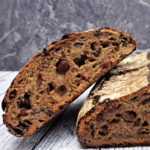
Spiced Fruit Sourdough Loaf
Spiced Fruit Sourdough uses my easy, no-knead bread baking method to create a loaf full of rich flavour. Dried fruits are steeped in honeyed black tea and orange zest and folded into a spiced dough made the night before. Using the soaking liquid in place of water in the dough adds even more flavour.
Ingredients
For the fruit:
- 500 ml hot black tea
- 1 tbsp honey
- 75 g raisins
- 75 g currants
- 1 orange, zest only finely grated
For the dough:
- 600 g flour (e.g. 200g rye/400g white wheat)
- 1.5 tsp salt
- 1 tsp cinnamon
- 2 tsp mixed spice
- 60 ml sourdough starter approx 60g if measuring by weight
Instructions
The day before you want to bake the bread
For the fruit:
-
Dissolve the honey in the hot tea.
-
Combine the raisins, currants and orange zest in a heatproof bowl and pour the hot tea over. Cover and leave for 3-6 hours.
-
Using a fine sieve, strain the fruit over a jug, reserving the soaking liquid. Set fruit aside, covered in the fridge, until the next day.
-
Measure the soaking liquid and make up to 400 ml with tap water if necessary. Set aside until you're ready to make the dough.
For the dough:
-
In a large bowl, stir the flour, salt and spices together.
-
Dissolve the sourdough starter in the reserved soaking liquid.
-
Stir the liquid into the flour, salt and spices. Bring together into a rough dough that leaves the sides of the bowl clean.
-
Cover the bowl with cling film and leave overnight or 14-16 hours.
On the day of baking:
-
Scrape the dough out of its bowl onto a well-floured worktop and flatten out.
-
Spread half the soaked fruit over the dough. Fold over the sides of the dough to cover the mix and flatten the dough again.
-
Spread the rest of the fruit over the dough, fold over the sides again and continue folding until it's distributed evenly
-
Shape your loaf to the proving vessel, cover with cling film and leave to rest 10 min.
-
After 10 min place the dough into lined, floured proving basket or tea towel-lined bowl, cover with cling film and leave for 90 min.
-
After 60 min preheat oven to 250C/500F/Gas 10 and put a cast iron pot with lid into the oven.
-
After 90 mins, carefully flip the dough from the proving basket into the pot, slash the top, replace the lid and put in the oven. Turn heat down to 220C/425F/Gas 7. Bake for 30 min.
-
After 30 min remove pot from the oven, take bread out and put bread directly on the oven shelf. Bake for 10-20 min until the bread is cooked through, turning down the oven if necessary to stop the outside burning
-
Leave on a wire rack to cool.
Recipe Notes
Different flours will absorb varying amounts of water so you may need to increase or decrease the liquid measurements.
To make Chai Masala Spiced Fruit Sourdough variation: use 3 chai tea bags and 1 regular black tea bag to make the tea and replace the mixed spice and cinnamon with 3 tspn of chai masala mix.
ENJOYED THIS RECIPE? YOU MAY ALSO LIKE:

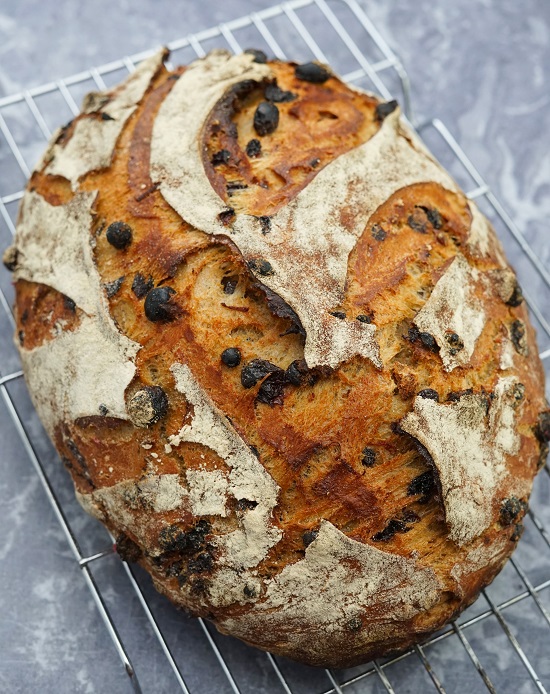

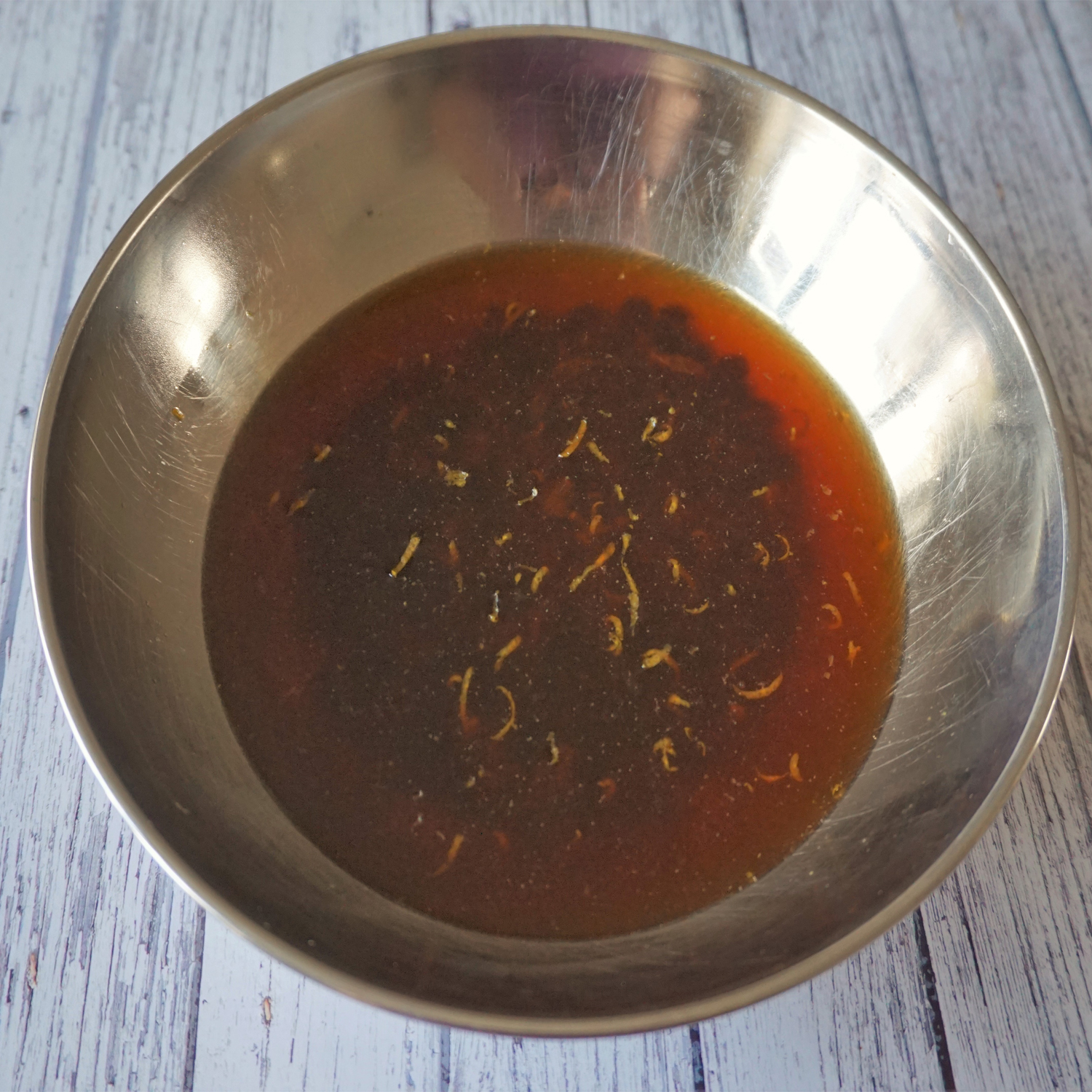
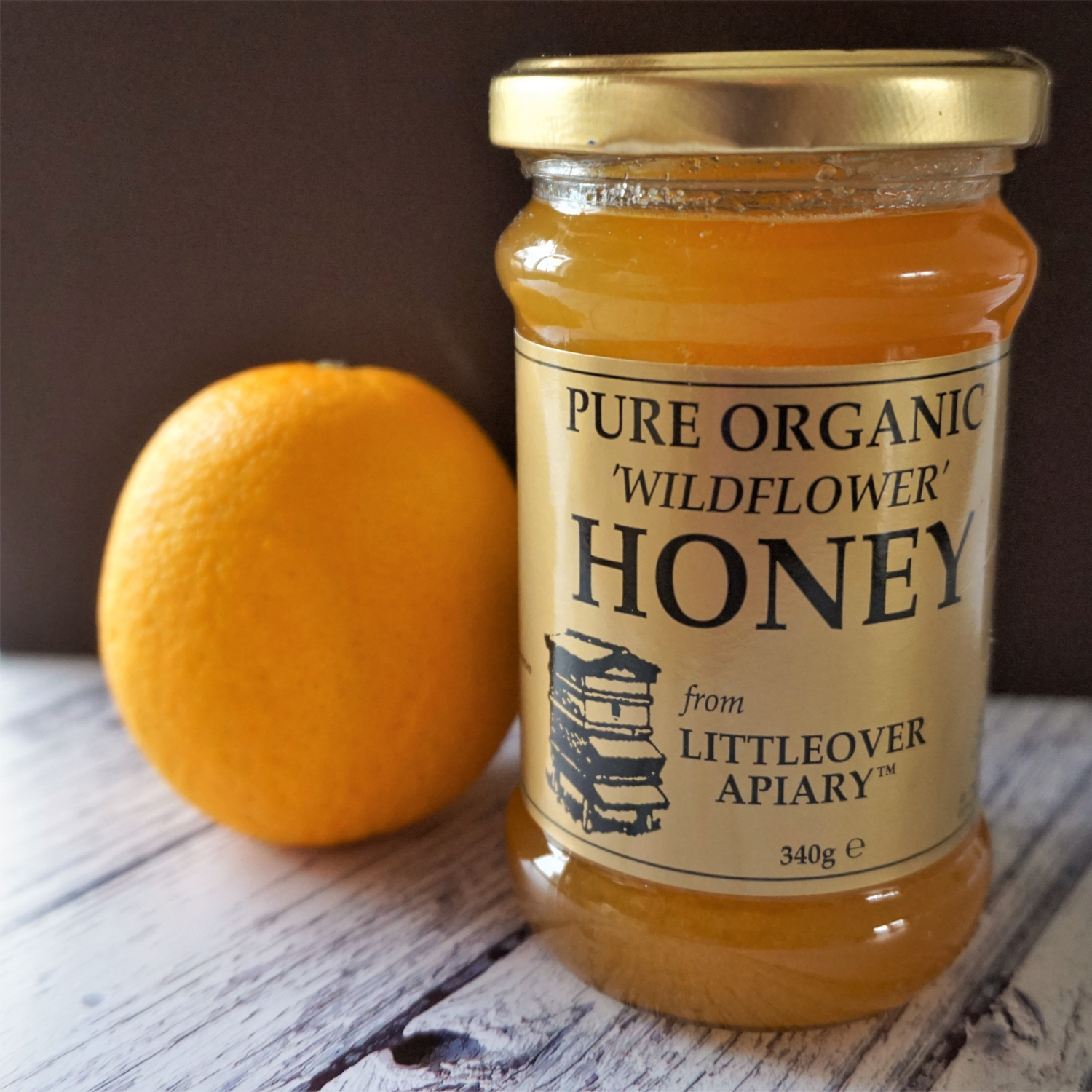
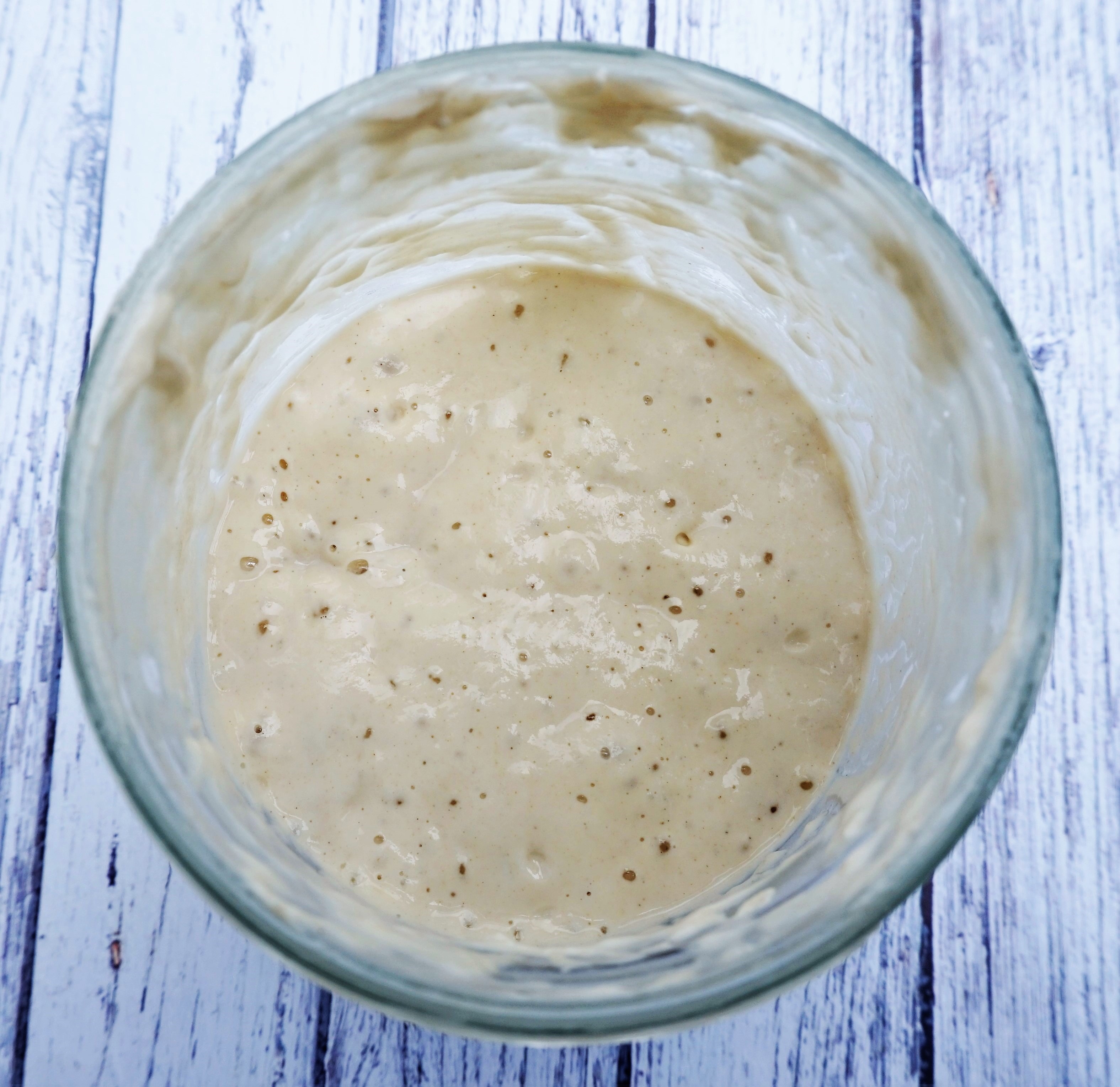



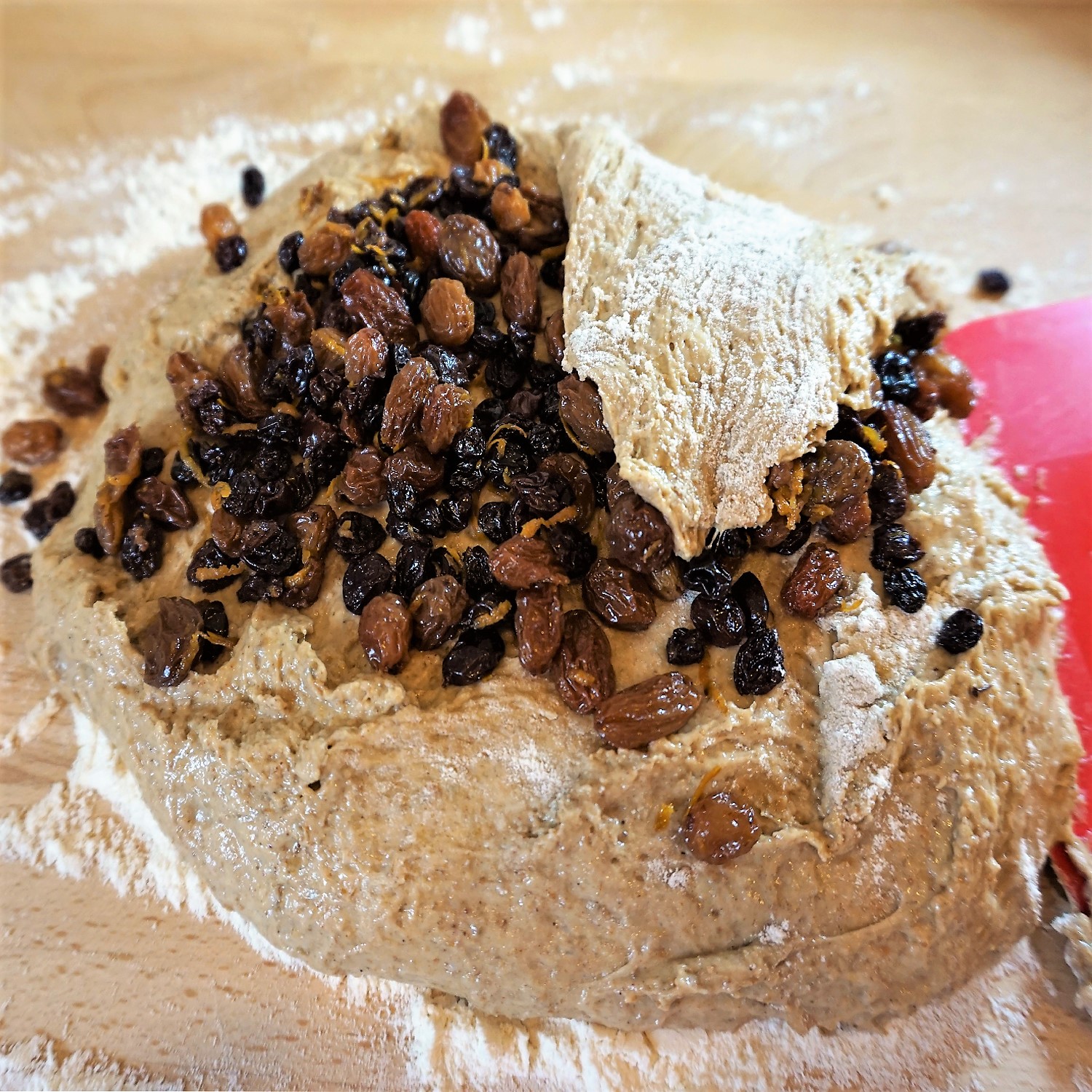
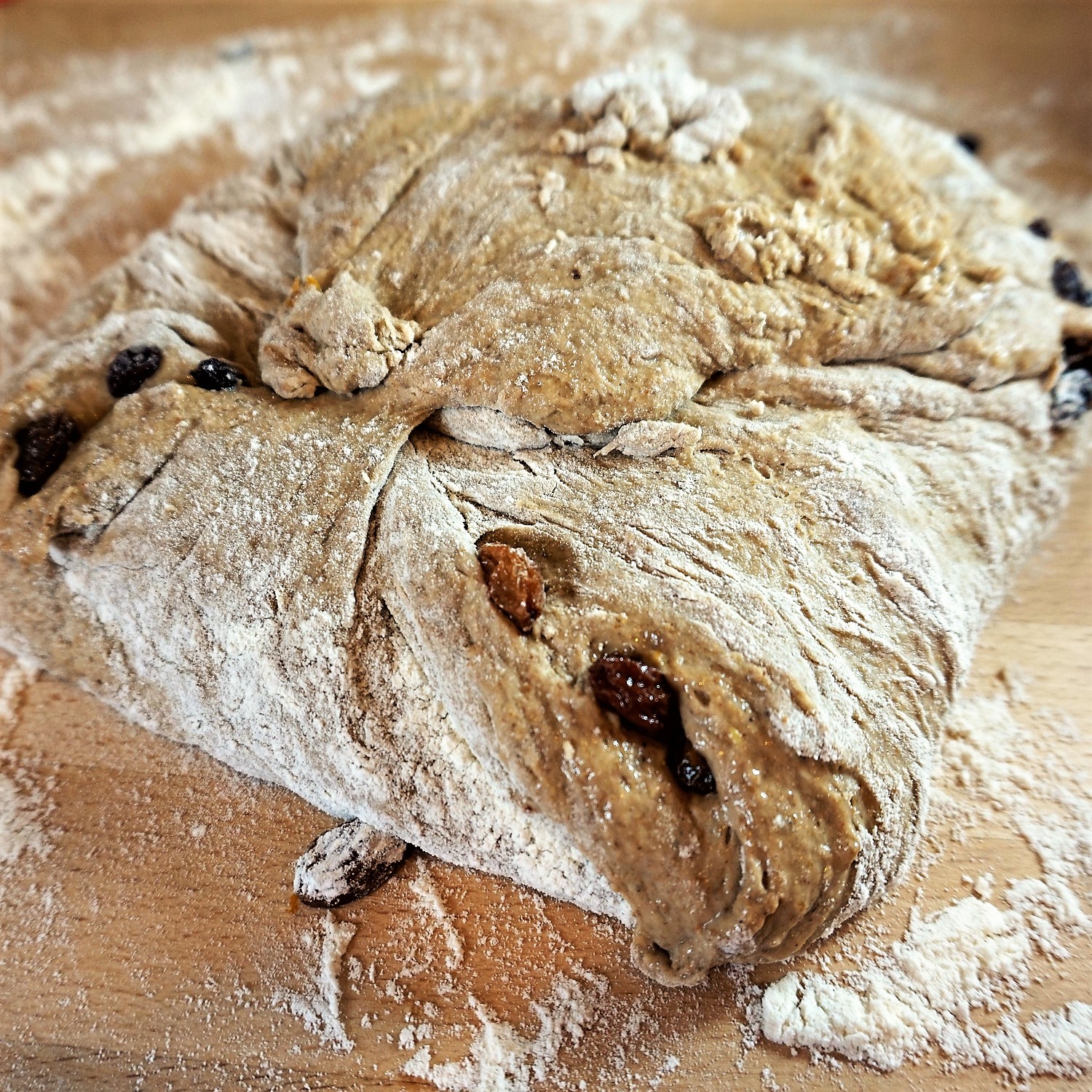
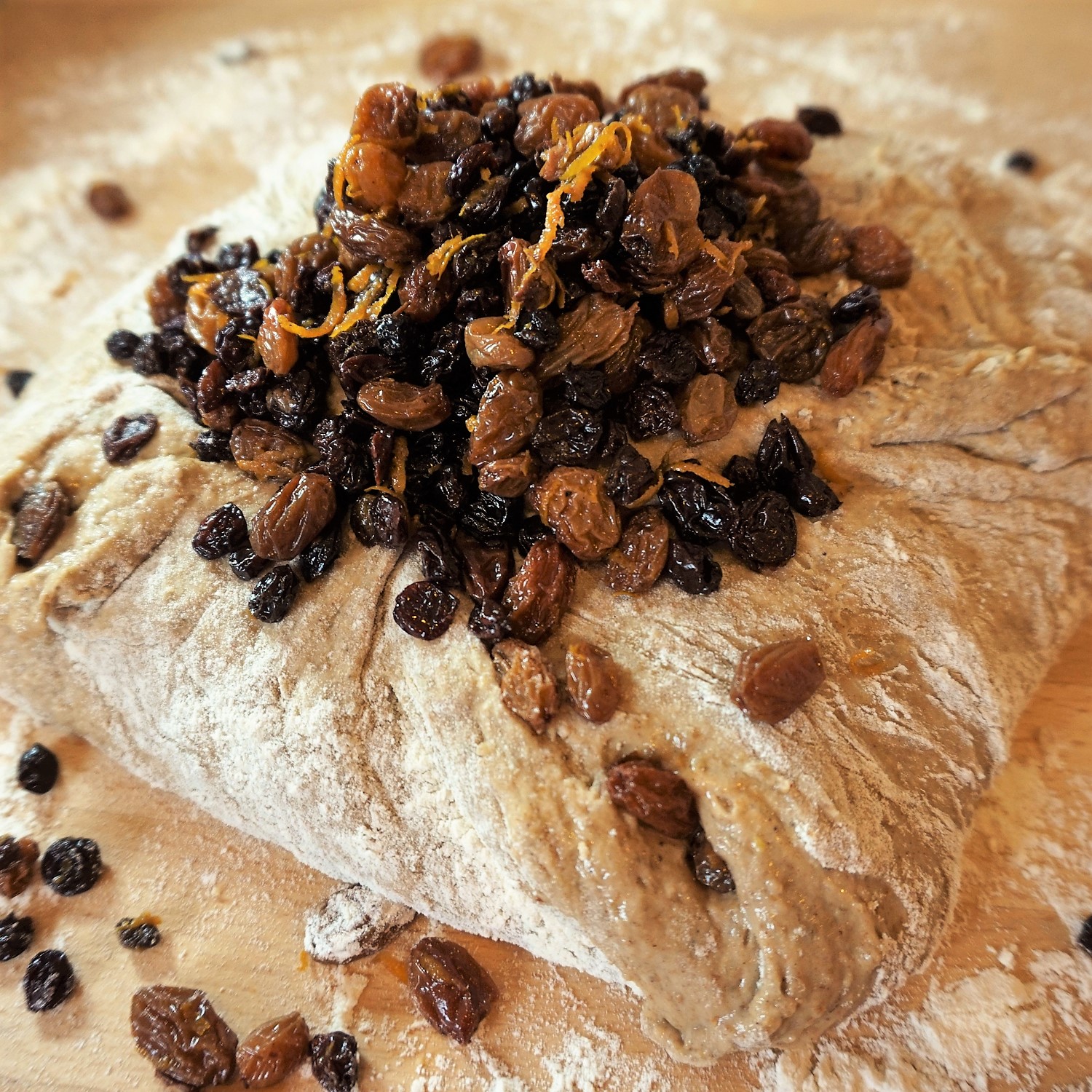

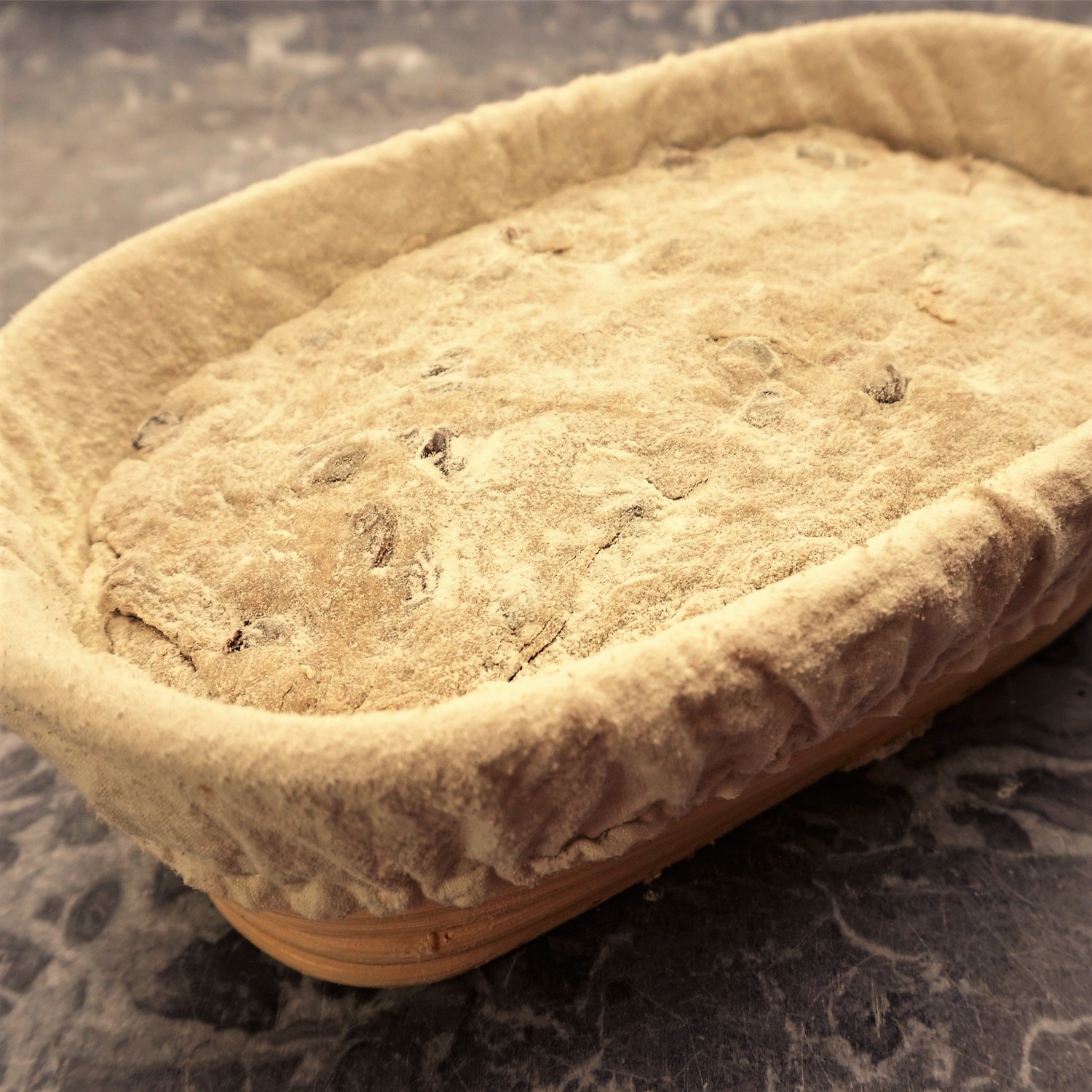
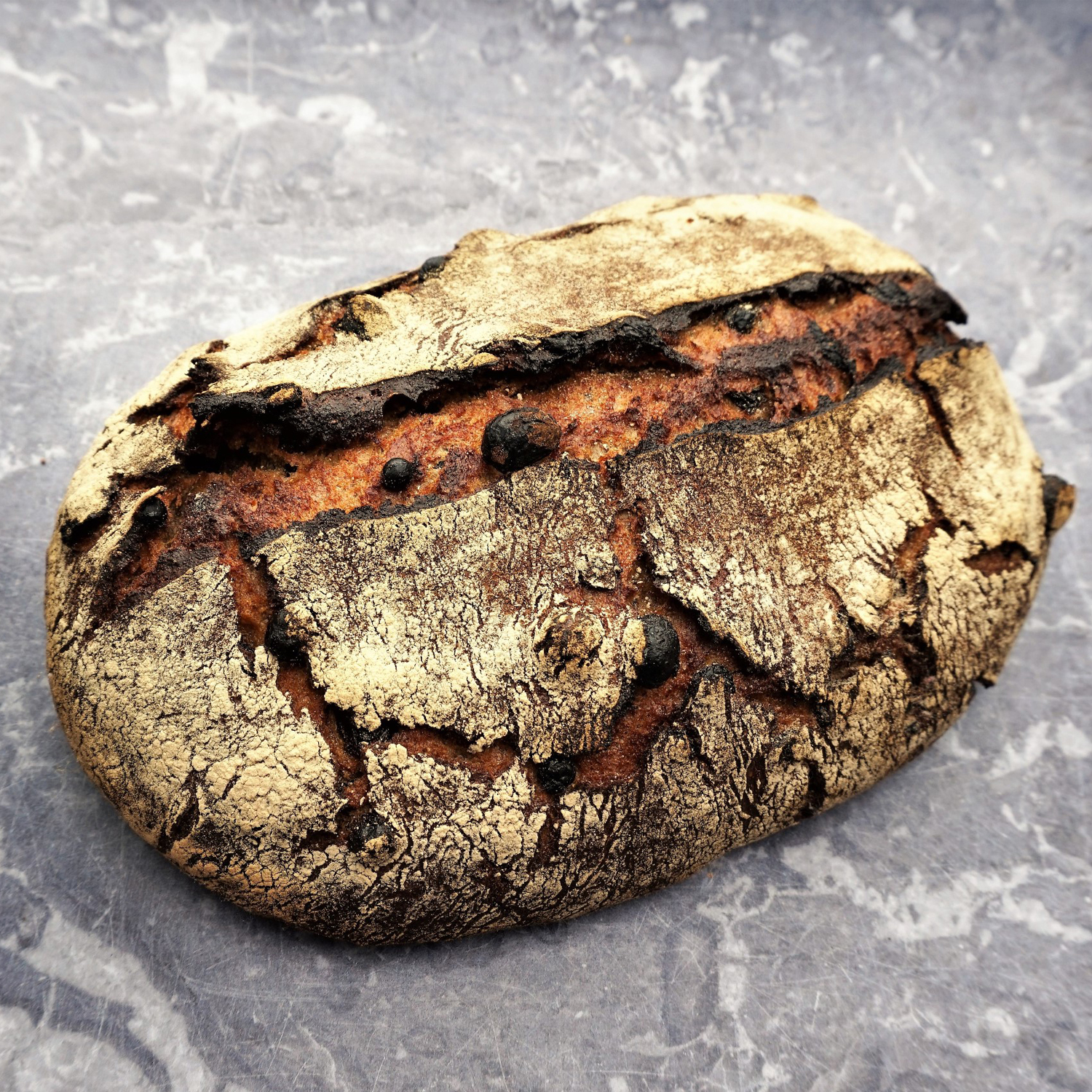
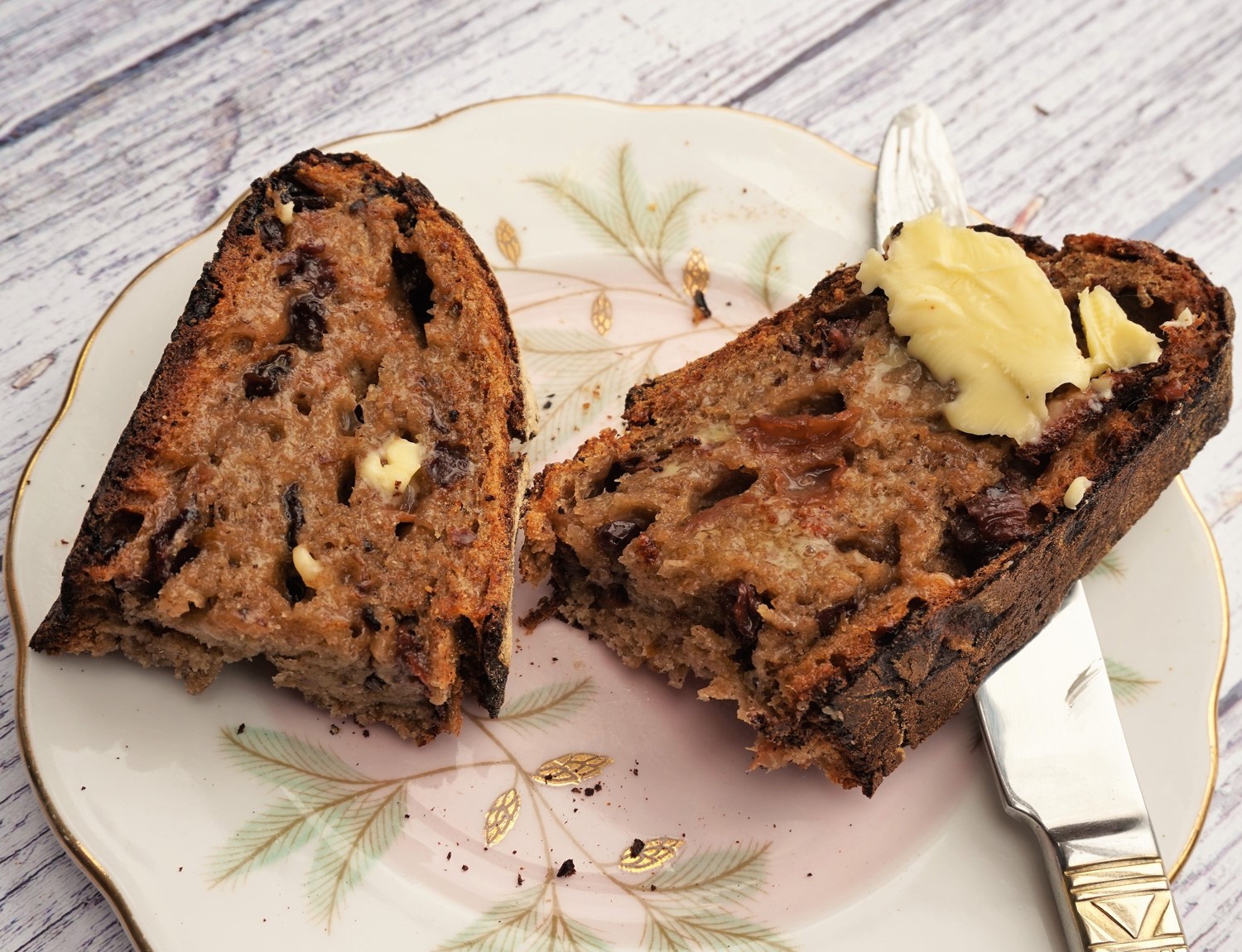
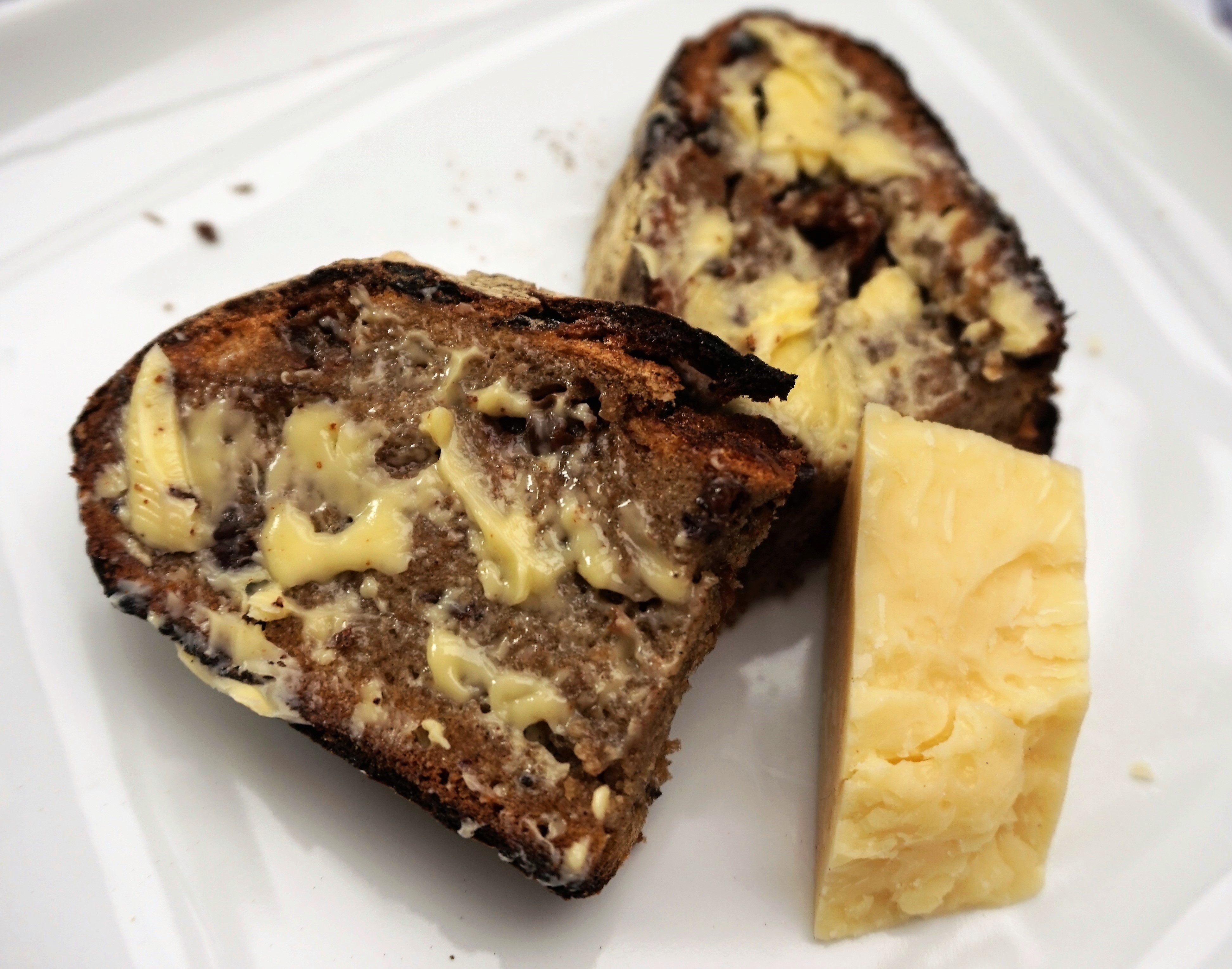
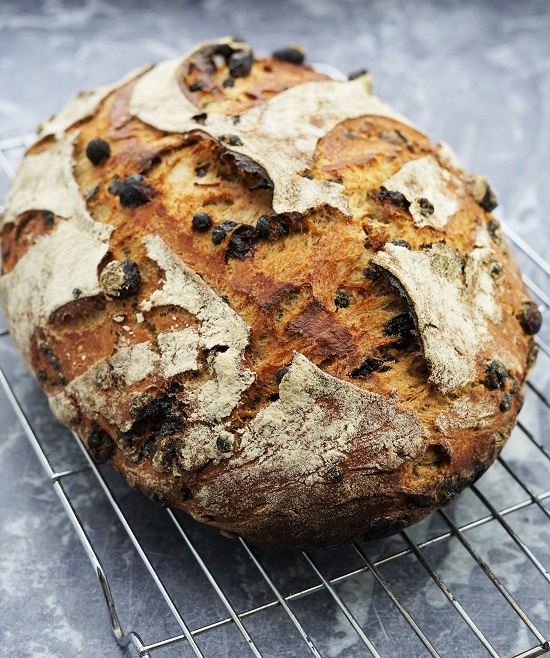

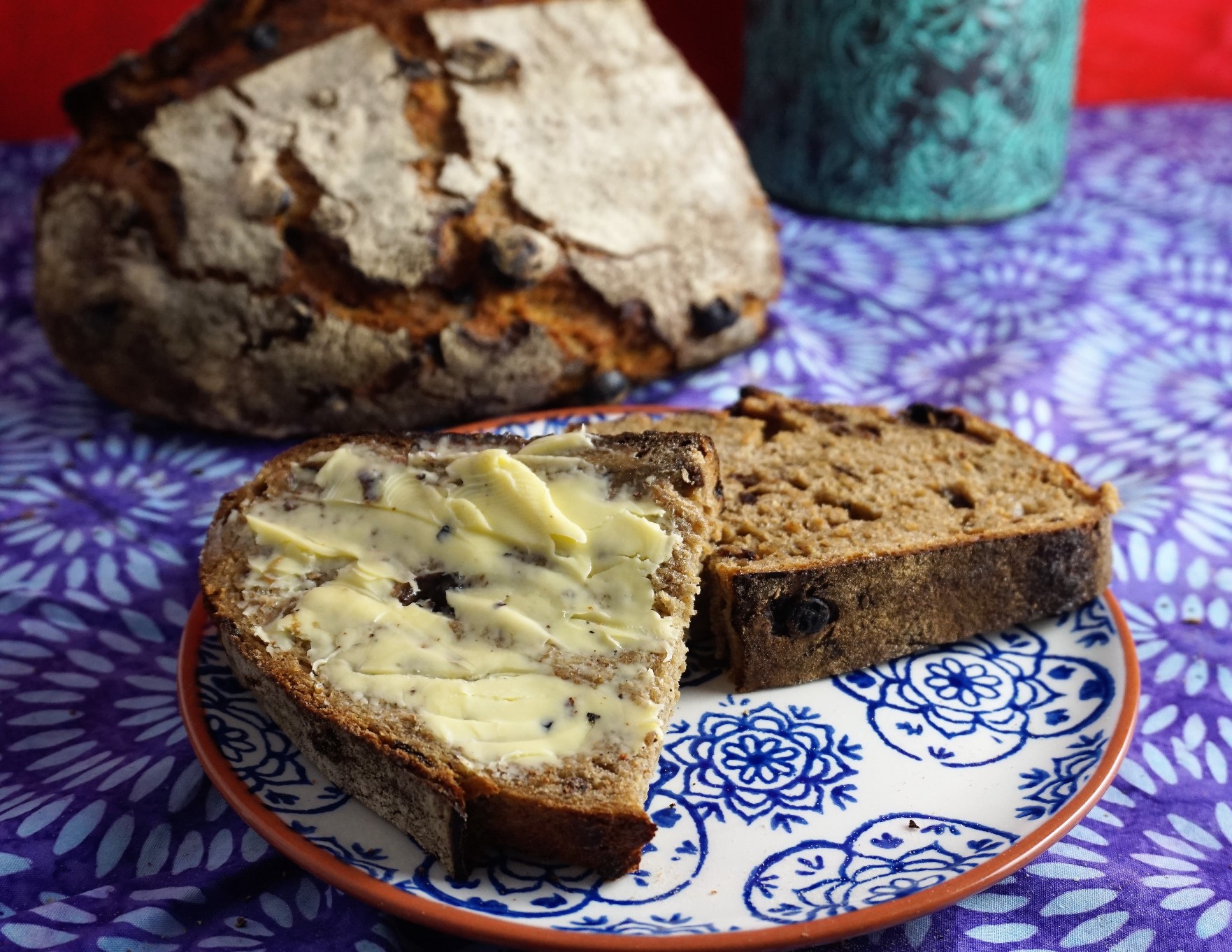

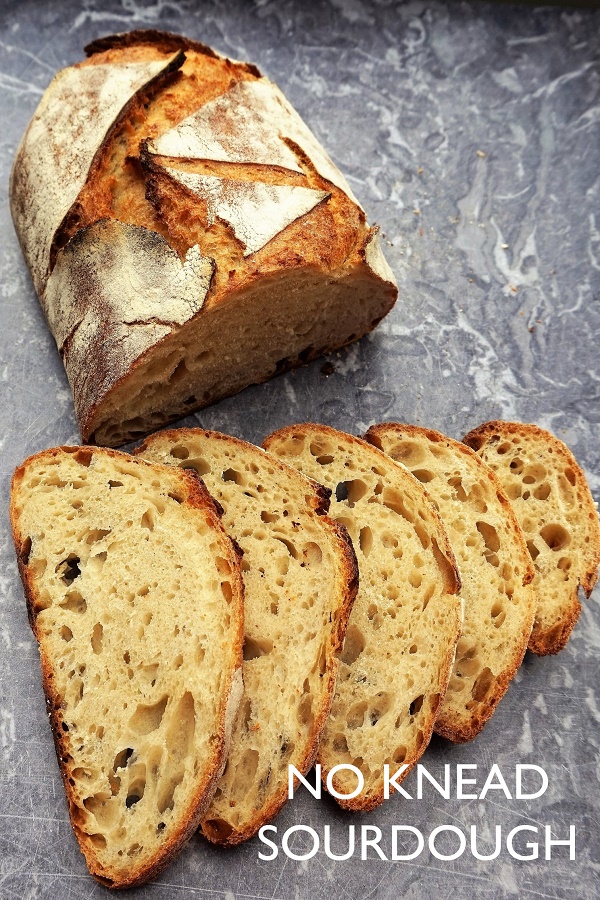
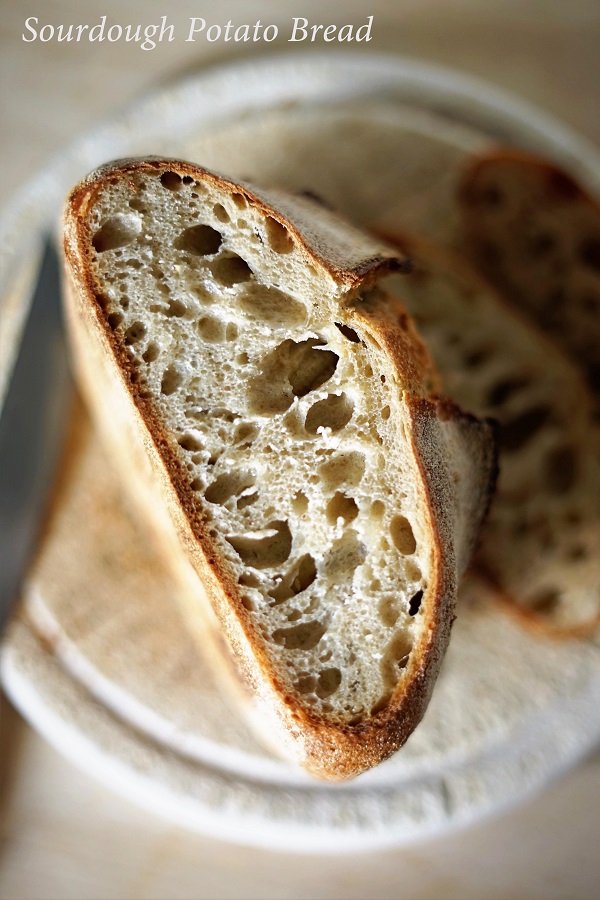
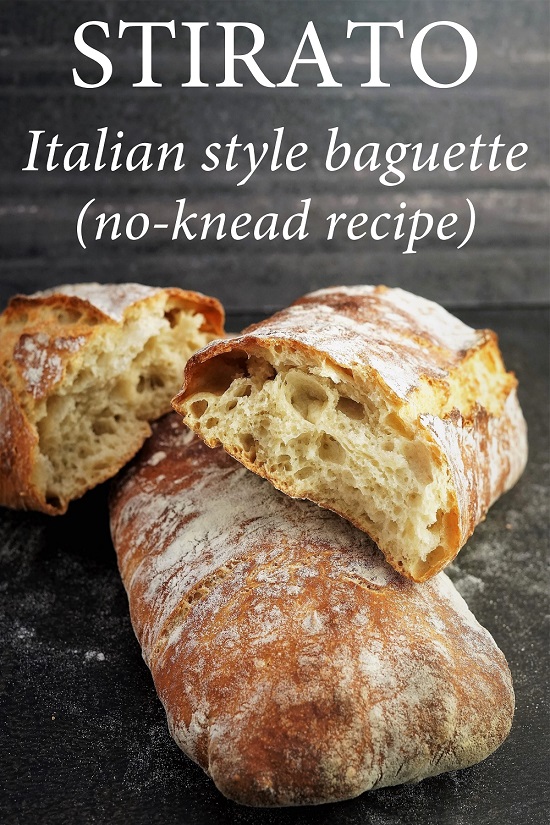
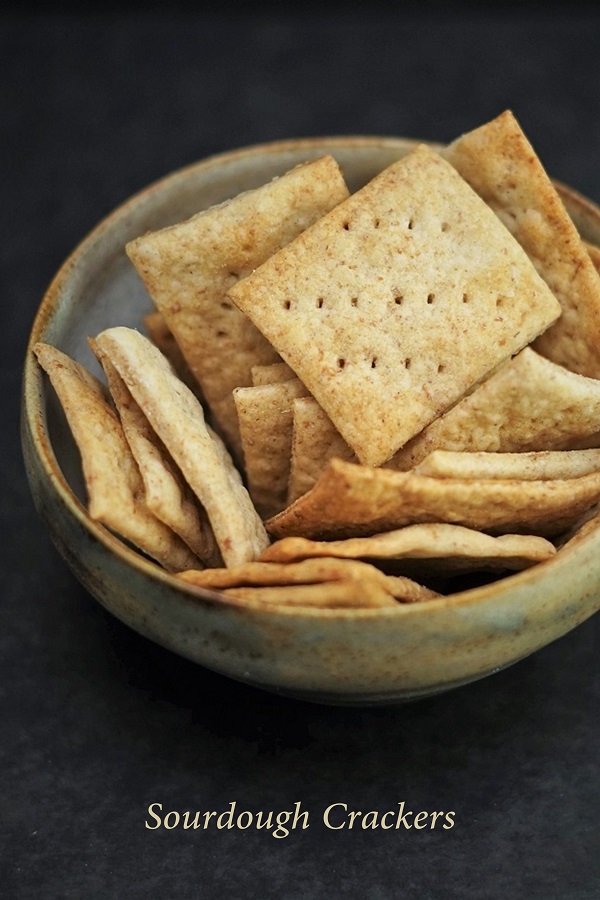

Tried this recipe yesterday and loaf came out perfect this afternoon. Was worried about rye flour as I struggle with it and after 19 hours it really didn’t seem to rise much. However I came out great. My only mistake was not working the fruit in more, but that was my mistake. So happy to have another successful sour dough recipe. Thanks
Yes, rye can be difficult due to its lack of gluten forming properties. But so pleased it came out great in the end, Rhoda! 🙂
I arrived here after searching for a fruit sourdough recipe. Having developed my technique via Tartine which an autolyse period without salt, then 4 hours of stretches and folds every 30 mins before an overnight fridge prove, I was sceptical.
I used this recipe with my usual 300g starter and process and the result tasted amazing – when a 600g loaf lasts 3 days in a family of 3 you know you have a winner. I was spurred on and returned to make a white loaf following your no knead recipe precisely. The result was superb – I got the open, chewy texture I have been searching for. I have just adjusted my starter feeding and will be doing it again. Just when you think you are starting to understand something you learn something knew that throws it up in the air! Thankyou.
Thanks so much for the detailed feedback and kind comments, Ian! So pleased that you got great results with my recipes.
Just made this and it worked out great!! Only thing I did differently to the recipe was to do my usual stretch and folds 30-60 mins after mixing the flour and starter etc., and started to mix the fruit in on the second set of stretch and folds. Might add some nuts next time and try the chai spices. But it looks and tastes delicious!! Thanks! 🙂
Thanks for the great feedback! So glad you enjoyed my recipe. 😊
Hi there,
I’m interested to try your recipe! I’m a new beginner baker though. I would like to know what is your starter hydration. I have a 100% hydration starter and I find that the sourdough bread I made are quite sour. Appreciate if you can share your starter recipe for this recipe. Thank you!
Hi Mel, I’m afraid I don’t have a recipe for my starter on the blog as I made it around 13 years ago: a long time before I started my blog! If you want to make a new starter then you could try this simple version from the Real Bread Campaign: https://www.sustainweb.org/realbread/bake/jan19_simple_sourdough_starter/
I’m no sourdough expert, but for a less sour flavour the advice is usually to go for a lower hydration which will give you a stiffer starter and also feed little and often rather than one larger feed. These should slow down the growth of the lactic acid bacteria that gives it that tang.
Hope this helps!
Hi! Thanks so much for your reply! I appreciate it. I have tried your recipe and enjoyed the process of making it. I used a 50% hydration starter and unfortunately the bread had turned out really dense like overly dense and the crust rather hard. I’m making it more enjoyable by eating it with butter. Im not sure how to fix it and my dough didn’t turn out shaggy or soft like yours. Mine was quite firm. Also the spices and fruit didn’t quite have a significant fragrance or flavour either. I doubt it is the fault of the recipe if others are getting it right, I just don’t know what I’m doing wrong. 🙁
Hello again, Mel.
Sorry to hear you didn’t have success with this recipe. I wonder if the problem is your starter?
In your previous comment you said your others breads have been too sour, and now this one turned out dense and hard. Perhaps your starter isn’t lively enough and needs feeding more often?
As you say, others have had success with this recipe, so I can’t think what else could be the problem. Sorry I can’t be more helpful 😕
This recipe is amazing and subconsciously took me back to early childhood when my mum would make traditional fruit tea loaves, something I had forgotten about, but the smell of the black tea, currents, orange peel and spices brought right back to me.
I adjusted the recipe slightly and used wholewheat instead of rye and I added in some lovely large yellow sultanas. I bulk proofed for 8 hours at room temp and then shaped, put in a banneton and left it in the fridge for 24 hours. I’ve found when it’s this cold the scoring and oven spring are much more effective! It’s risen beautifully and I’m about to take it out the oven. I can already tell it’s going to be so tasty!
It pleases me so much that my recipe brought back those memories for you, Pippa! Interesting to hear your method for proofing too.
Thanks so much for getting in touch: I hope the taste lives up to your expectations!
Good morning,
I have been proofing my dough overnight and will be baking today. I was wondering if you oiled the pot before adding the dough to it. Concerned that it will stick.
Thanks!
Hi Charles, no I don’t oil the pot. I don’t have a problem with sticking to my pots, but if you’re concerned, just before tipping the dough in, sprinkle some flour in the bottom of the pot.
Lovely large loaf that fed 9 of us easily for Sunday breakfast, toasted and served with butter & home-made jam.
Thank you for the lovely feedback. Your Sunday breakfast sounds great!
Oh my god, first time making sourdough it worked perfectly. Love, love, love it
Wow: so wonderful to hear that you chose my recipe for your first time making sourdough and you loved it! You’ve made my day 😊
Thanks so much for your feedback.
I made this using 200g of my 50/50 rye starter (can’t waste it!) and reduced the flour and liquid in the recipe by 70g each to counter that. I make spent-grain sourdough quite frequently, and it’s good, but I NEVER get oven spring. This recipe sprung spectacularly and is soft and delicious with a great crust! I wish I could send you a photo! Very happy, will be a regular for me!
That’s lovely to hear, Rochelle! So pleased my recipe went well for you.
Many thanks for taking the time to let me know 😊
It’s as if a hot cross bun and a sourdough loaf had a baby. Excellent recipe, i followed this step by step and out turned out wonderful.
Love it! 😄😄
Thanks for your great feedback Alwyn!
I was looking for an easy sourdough fruit loaf and this one looked just right. I substituted half the honey for molasses and used wholemeal stoneground organic flour. I needed a lot of extra water! It was a little soggy at this stage, but was fine after proving. I also reduced the spices slightly, , it was a lot more than I usually use in a cake. No Dutch oven either, but I covered the bread with a dome made of silver foil to stop burning in the early part of cooking. This is the most delicious cake? ! I thought it was low fat till I started spreading butter on it😅 The only problem I had was that it was difficult to incorporate the soaked fruit in the dough, they just didn’t want to mix, but I expect I’ll get better with practice. My usual baking powder fruit cake may now be consigned to history!
Hi Debbie, glad you enjoyed the recipe!
As you found, substituting in wholemeal flour does mean you need lots more water and yes, incorporating all the fruit does get easier once you’re used to it!
Many thanks for taking the time to give your feedback and rate the recipe!
Such an easy recipe to follow and so tasty,. I took my sourdough starter out of the fridge on Thursday and it was fed and ready for Saturday evening mixing. It rose really well in the oven and the smell and taste is really good. I will try your version of the no knead sourdough next weekend. I used raisins and sultanas soaked in Lady Grey tea I also added a squeeze of vegan honey.
Thank you for your lovely feedback Adrienne. So pleased you enjoyed making this bread, it’s one of my favourites!
This bread is delicious. During Covid my friend Giselle and I bake bread together via video. It is lots of fun. I used Spelt flour instead of Rye and Giselle used rye and we both substituted cranberries for one of the raisins. We had to make our own mixed spice, as in Canada we don’t have it. At least we have not been able to find it! Anyway,
We live in Alberta thus we are 2200 feet above sea level. We had trouble adjusting temperatures and figuring out how long to cook the bread for.
Can you tell me please what temperature the bread is supposed to be when it is cooked!
And will this be the same temperature for your roasted onion and bulgar bread?
Peggy
Hi Peggy,
So pleased that you found the bread delicious and had fun making it!
I don’t measure the temperature of bread, so I’m afraid I can’t say what temperature would indicate that it’s cooked. As a general rule, people who do measure bread temperatures seem to suggest 90-95C.
However, this isn’t something I can confirm as I just use my experience and the sound the bread makes when you tap it underneath: it should sound hollow. If in doubt, I’d always cook it a few minutes longer (and with the oven at a slightly lower temperature if you think the crust’s browning too much).
Hope this helps!
Absolutely delicious, a real hit., filled my house with the smell of Christmas. Thanks you so much.
I was a little nervous as my initial prove was more like 18hrs just because I didn’t get round to baking it until the next day . I also needed to be quite generous with the flour as I needed in all the wet fruit, there was so much fruit I thought I would never incorporate it all.
The loaf was absolutely delicious though and didn’t last very long!!
Thank you for your lovely feedback, Paul! Really pleased you enjoyed this loaf.
I started sourdough baking during lockdown and am now completely hooked. Thank you so much for this recipe, which will be my first venture into a fruit loaf. My husband loves all fruit cakes/breads so I am making it for him as a ‘birthday cake’. It is proving right now. I am a little concerned that my dutch oven will be too small , it is only 22cm, but I wanted to try it out before I invest in a bigger one. I’ll let you know how it goes!
Will be interested to hear how it goes, Tanya!
It worked a treat! Great recipe, thank you. My husband was delighted! I’m now in the process of doing your no knead sourdough loaf. So much easier than the usual method. Thank you so much!
Thank you Tanya! So glad you enjoyed the recipe and thanks for taking the time to comment and rate the recipe 😊
I’m Bout to start this recipe, a quick question – the 60ml starter, what would that equate to in grams? 60ml water is 60g water, but as starter is heavier would it be 100g, 120g? Thanks! 😊
Hi Jenny,
I use a quarter cup/60ml measuring cup as I find it convenient so don’t know *exactly* what that amount of starter weighs.
I don’t think you need to be terribly exact anyway as the weight of 60ml of starter will also vary between starters, the flours used etc.
However, assuming your starter is 50:50 flour and water:
30ml water is 30g
30ml (1/8 cup) of flour is generally converted as around 30g.
= 60g in total.
Although it feels like the starter should be heavier than water alone, it actually isn’t. That’s because, by volume, flour is lighter than water. So a certain volume of flour and water mixed together is actually lighter than the same volume of water alone.
Hope this makes sense!
Thank you!
No problem, Jenny!
It was actually quite useful for me to have to think this through in order to explain.
Also a lesson for me that when writing up recipes, sticking to grams is probably best!
Hi, made this fruit loaf again but for some reason which I’m not aware of didn’t work as beautifully as the first time i made it. It was a fairly stiff dough to start with and I’m positive I used the 400ml liquid. I used 500gr bakers /bread flour with 100gr whole meal flour. It turned out quite dense… still tastes good though.. thanks for any feedback
Hi Rita,
If the dough was fairly stiff then you may have needed to add a little more liquid. The amount of liquid flours absorb can vary between brands or even different batches of the same flour, so although the recipe says 400ml this is really just a guide.
The other possibility is that perhaps your starter wasn’t lively enough?
Putting the bread in the oven at the right time is important too, when the dough is neither under or over proved. These days, I do the ‘poke’ test: gently prod the dough and see how quickly the impression springs back. If it comes back very quickly, it’s not ready. If it comes back quite slowly but there’s still a very slight depression then I consider it ready to bake. If it barely springs back at all then it’s probably over-proofed.
Hope this helps!
Oh, how lovely it looks! I really cannot wait to try this recipe!
Sadly, I currently only have rye flour at home and due to the current world situation, it’s not very appealing going to the market where I live!
I’m imagining it might get a little ‘heavy’ with just rye, so I’ll have to wait in excitement till I get my hands on some more flour 😀
I agree, Alex. I think all rye flour would make this loaf too heavy. Hope you get to try it soon.
Wow, what a fantastic recipe. I didn’t follow ingredients religiously – I soaked the fruit in orange juice and hot water as I didn’t have an orange for zesting. I also substituted maple syrup for honey. No Dutch oven or crock either. Just used 1/2 cup of boiling water in a tray to create steam. I can’t wait to try it again. Mixed the dough in the evening and it had risen very well by the next morning. Thanks for sharing your recipe.
Thanks for the feedback, Lorna!
Really glad you liked the recipe and love that you successfully adapted it to your particular circumstances. That’s what I love to hear! 🙂
This was amazing! It’s so soft and has a delicious flavour, it rose beautifully. I did a mix of half bread flour and half plain flour and left it out at room temperature for 11 or12 hours before putting it in the fridge overnight.
That’s wonderful, Katie! I agree this really is an incredible loaf. And easy too.
Thanks so much for taking the time to comment and rate the recipe. 😊
I love this recipe! Works a treat. I do a version with dark rye bread mix in place of the plain rye. I make a fast version using 250gm sourdough starter at 100% hydration and 360ml of black tea and rasberry tea infused with the fruit and honey. If I start at 8am I am baking at 8pm.
Thanks for the lovely feedback, Graham. So glad you love the recipe!
Your black tea & raspberry tea version sounds great.
I made this at the weekend and it came out wonderfully. Switched out the honey for dark agave syrup so it’s vegan.
Really good crust and crumb, gorgeous sourdough flavour. I really like your overall sourdough method too – seems to give a much better oven spring. Currently in the throes of making the onion and bulgur wheat version 🙂
Hi Lyssa!
Thanks so much for your lovely feedback. 🙂
Hope you like the onion & bulgur version as much as the spiced fruit sourdough!
Followed this recipe and just took the loaf out of the oven and it looks amazing. Cannot wait to slice into it. Wish I could send you a photo. Thank you for the step by step photos too as I’m a novice at sourdough baking and it helped a lot . I’ll be saving this one for sure
Thank you for the lovely feedback, Rita. So glad you liked this recipe & I hope you enjoy the taste just as much!
If you’re on Instagram you could always tag me on a photo. I’m also on Facebook, Twitter & Pinterest 🙂
Hi, I made the mistake of not using my normal corn meal in the pot and it stuck, ha ha ha.
It came out in two pieces, a top and a bottom.
I am resident in the Philippines and unable to procure lots of ingredients so I need to adapt.
I love the recipe and have shared it widely.
Many things are said and done that I don’t understand, what is the advantages of a proving bowl as opposed to just a bowl, what is the action that is occurring?
Like another reply, I was shocked at the small amount of starter and I increased it to 100 mls.
I also adjusted the recipe by adding some rum to the tea and fruit.
Love your site, great recipes.
Hi Ross,
Yes, the fruit does mean the dough’s quite sticky! Glad you loved the recipe anyway – and I love the sound of adding rum!
I don’t think there’s any particular advantage to a special proving bowl over any other bowl. It’s really just for convenience.
Many thanks for taking the time to comment and rate the recipe.
Hi I’m preparing all the fruit and will make tonight thanks so much, I’ll let you know how it goes! Just a question, is 60ml of starter that correct amount? It seems like a small amount for that amount of flour, I usually make my bread loafs with a cup of starter and it has half the amount of flour. I’m definitely no expert but just wanted to check before mixing tonight 🙂
Hi Christina,
Yes, that’s definitely the amount I use for this recipe. I actually use an American quarter cup which is 60ml as it makes measuring easy in this case.
If you’re more comfortable using a bit more (say up to 100ml) I doubt it will do any harm. Obviously though I can’t guarantee the same results! 🙂
My dough did not rise at all in the first rise which I did in the fridge overnight. Is it possible the acidity of the black tea killed off the yeast? I have used the same starter for another white plain loaf which rose beautifully so I know my starter was not the issue. Will give it one more go as the combination smelled divine..
Hi Robyn. Sorry to hear this.
I’ve never heard of a problem combining yeast and black tea, in fact it’s been used in traditional fruit breads for many, many years.
You don’t say what the finished bread was like? Did you actually bake it? Did it rise in the oven?
Other things to consider:
1. Was your sourdough starter lively and bubbly before you used it? If not, then the dough will not rise.
2. Was the tea still warm when you mixed it with the starter? The recipe calls for cold tea as heat will kill the yeast and the dough will not rise.
3. Are you somewhere particularly warm so felt you needed to put the dough in the fridge overnight? It may have needed another rise at room temperature.
Sorry the recipe didn’t work out for you, but as you can see from the other comments, those who followed the recipe as written have had five-star results.
I hope you’ll try it again and get a great loaf as the others have. Do let me know.
I love this recipe just by reading it.i am making one right now,substituting the mixed spice with zaatar spice i have just made at home.i live in malaysia average temperature is 30-32 celcious degree. After miximg the dough i put it inside the fridge lets see what happen tomorrow morning. I have tried on another recipe putting it on the counter overnight,my dough just went over overproofed that it collapsed when scored and baked. What do you suggest?
Hi Michelle,
Sounds like you’re doing the right thing by proofing the dough in the fridge as temperatures are so high where you are. Once you’ve shaped the dough you’ll probably find it needs only a very short second rise.
A good way to test what stage dough is at is the ‘poke’ test: when you think it might be ready to put in the oven, give it a poke with your index finger and see how quickly the impression springs back. If it comes back very quickly, it’s not ready. If it comes back quite slowly but there’s still a very slight depression then I’d consider it ready. If it barely springs back at all then it’s probably over-proofed.
Love the sound of making it with zaatar! Which reminds me I need to make another batch too 🙂
Do let me know how it goes!
I had my in fridge ,and that was mistake ;),hope for good outcome.
Hope the loaf ended up ok, Marinka.
Made this with espresso coffee to soak the fruit, was beautiful. Trying some T2 strawberry and vanilla flavoured teas for this next bake. Great recipe, only problem is the end result doesn’t last long enough!!
Wow! Your coffee version sounds intriguing!
Thanks so much for the great feeback, glad you like the recipe!
This sourdough fruit loaf is totally delicious, I’ll never buy fruit loaf again.
That’s great, Tracey! So glad you like it & thanks for taking the time to rate & comment. ☺️
Hy Lynne
I tried the Spiced Fruit Sourdough recipe for the first time yesterday and am happy with the result (jest finished two slices of the bread for breakfast). Because of a scarcity of flour in the current virus panic buying period I only used a white baker’s flour for the recipe, along with my white sourdough starter.
After watching another blogging baker recently I didn’t combine the liquid with the starter but allowed the mixture to autolyse for 30 mins before incorporating the starter.
When forming up the bread I found that the mixture was very wet and hard to work with but managed to get it into my cooking vessel (a clear covered pyrex bowl like Leo at Riot Rye uses). I made the mistake of only flouring the lid of the dish when I flipped it for cooking and consequently the loaf stuck to the base after cooking.
Nonetheless I am happy with my first attempt. I might experiment with the fruit mixture for the next loaf to see if I can reduce the moisture content of the fruit prior to incorporating it into the dough.
Would love some feedback so that I can improve my baking skills.
Cliff Hobson
Wyoming NSW Australia
Hi Cliff, thanks for your feedback. Here’s my thoughts.
I don’t autolyse so I’m not sure what effect this might have had on the outcome. Likewise, I wouldn’t advise using a pyrex bowl as it’s not something I’ve tried with this method. Mixing different recipes means you may not get the hoped for outcome.
As I say in the Recipe Notes, ‘Different flours will absorb varying amounts of water so you may need to increase or decrease the liquid measurements.’ It sounds like you need to decrease the amount of liquid. Also, individual’s sourdough starters will vary: some will be thicker or have more water content than others.
As for trying to reduce the moisture content of the soaked fruit, as I’ve written in the blog post, when you put it in the sieve push down on the fruit ‘to get most of the liquid out’. If you look at the images then you’ll see mine is quite dry when I incorporate it into the dough.
To summarise: sounds like you need to watch the liquid content at each stage (and experience will tell you what’s right for your conditions) and I’m sure your next loaf will be even better!
Absolutely delicious – I have made it 4 times and the whole family loves it.
Tried other recipes but this is by far the best (and so easy!! – I love the no-knead cook-it-in-iron-pot technique).
Thank you!!
That’s great, Caroline! The overnight no-knead method and cooking in a pot makes bread making so easy, doesn’t it?
Thanks so much for your feedback.
Thanks ofr your recipe and instructions. The bread worked out beautifully . It was a nice distracting challenge while we were instrcuted to #STAYATHOME
So glad you enjoyed making the bread. I’m doing lots of baking right now too!
A wonderful full flavoured loaf! I made mine in a tin for ease of toasting. Finally I can slice it and it is delicious! I used my favourite flour blend of organic white, brown rice, rye and whole meal and it is just perfect. Although the dough felt heavy – the crumb is light and airy with smaller holes. A slice needs nothing more than butter!
Thank you ! 😁
Very pleased to hear you love this loaf love as much as I do, Liz! Thanks so much for taking the time to rate and review the recipe 😊
EXCELLENT recipe. Made my loaf using Marks & Spencer’s Empress Earl Grey Tea and it’s so wonderfully fragrant my husband ate half a loaf all by himself this morning at breakfast! Baked it in a Dutch oven — it did blacken a little too much, so for my second loaf, I lowered the heat to 190C after removing the DO cover. Worked a treat! Thanks again for this. Putting the Chai Spice version on my list — will do it when I next get fresh spices!
Fantastic! So glad you liked the recipe. I always reduce the temperature after removing the bread from the pot these days & get much better results too. Thanks so much for taking the time to give your feedback!
I mad e this iin the remote Flinders Ranges in South Australia, in a dodgy oven. I used homemade espresso coffee instead of tea for the fruit soaking , and Tasmanian Leatherwood honey. I also added a bit of nutmeg as well as cinnamon, and included some dried peaches, dates and apricots. Delicious!!!!
Wow, Jono, that sounds great! Thanks so much for your feedback & for rating the recipe.
Fantastic Recipe!! About to make it for the 3rd time in two weeks,
Wow! Thanks for the great feedback, Catherine. So glad you enjoyed the recipe.
Made this fruit bread today, following the recipe with the exception of some additional spices ground in a pestle and mortar (cardamom seeds, nutmeg, a couple of allspice berries) – it is an excellent and low-fuss recipe with an outstanding end result. Love it!
So glad you liked the recipe, Donald. Love the sound of the extra ground spices you put in! Thanks so much for taking the time to rate the recipe and give feedback.
Thank you for this recipe. I really enjoyed making it and will discover how it tastes later- it looks brilliant!
Glad you enjoyed making my Spiced Fruit Sourdough. Hope it tastes good too!
Great recipe! I used white spelt with a light rye and it worked really well. Thank you!
So glad you found that the recipe worked well – white spelt and light rye sounds lovely! Always great to hear feedback – many thanks for getting in touch.
I needed a recipe for a sourdough fruit loaf and found this online. I followed this to the letter other than having to use syrup instead of honey due to a larder deficiency. It worked very well and was very tasty. Instructions were good and easy to follow. I doubt I will be able to comment on keeping qualities as I can’t see it being around long enough to test. Thanks for this. I’ll be making it regularly. I used a simple white flour starter but next time will try a rye based one. Playing with the fruit and spices will be fun but with such a straightforward base the possibilities are there to experiment. Thanks.
Many thanks for your feedback, John. So pleased you found the recipe easy to follow and enjoyed the loaf. I find bread making, experimenting with different flours etc. quite addictive. I really like the chai masala spice variation of the fruit sourdough.